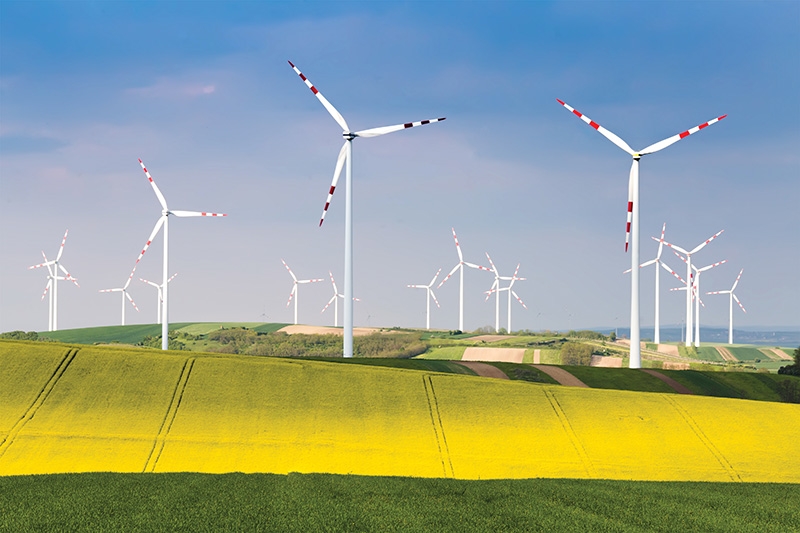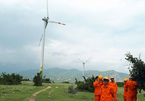 |
|
Vietnam boasts the highest capacity for wind power projects in all of Southeast Asia
|
France-based independent power producer Quadran International last week received the nod to study a wind power venture in the central province of Quang Binh, which is gaining attention from both investors both home and away.
Chairman of the provincial People’s Committee Tran Cong Thuat said that with the high potential to support 800-1,000MW of wind power, his province has received many proposals to invest in relevant projects in recent times.
In 2018 it was reported that Quadran International was also to invest in two solar projects in the south-central provinces of Binh Dinh and Khanh Hoa for a cumulative power of 85 megawatt peak. Its development objectives are to increase its current portfolio of 500MW of solar and wind power and to build 200MW per year.
These movements are in line with the provinces’ strategies, but other provinces are also seeing positive developments.
Thanks to the revision of the wind feed-in tariff (FiT) set by the government’s Decision No.39/2018/QD-TTg dated September 2018 on the revision of the wind FiT, the Vietnamese power market is seen as a positive as a series of wind power projects are settling in Bac Lieu, Ca Mau, Tra Vinh, Ninh Thuan, Binh Thuan, Quang Tri, and Phu Yen provinces. In addition, several long-delayed wind power projects have started construction again.
According to state-run Electricity of Vietnam’s (EVN) report released in January, 31 projects signed a power purchase agreement (PPA) with total capacity of over 1,600MW that are under construction, but have not reached commercial operation date (COD) so far.
Meanwhile 100 wind projects are waiting to add into the master plan during 2025 after 59 others has completed the procedure.
Last month the Ministry of Industry and Trade (MoIT) announced that it has received at least three proposals for supplementing the planning of wind power plants with a total capacity of over 1,000MW, a figure larger than the 2020 target.
The Vietnamese government has set a goal for wind development at 2,000MW by 2025 and at 6,000MW by 2030 in the revised power development master plan VII (PDP7), but it will not stop there as targets to deploy total wind power capacity is expected to increase in a new power master plan for 2021-2030, with a vision towards 2045.
Now is the time
Under Decision 39, the rate for onshore wind power is set at 8.5 US cents per kWh, and offshore wind power at 9.8 cents per kWh. These rates are applicable to projects that reach COD by November 2021.
Industry insiders have said that the current FiT for wind power projects is feasible, and investors are trying to push projects ahead to reach COD as there are no guarantees about pricing of connecting projects to the grid after this date.
Besides that, financiers believe that there will be growth and investment in the wind sector for now, with solar power development temporarily reduced. They are awaiting a new final rate to FiT applied from June 30, 2019. The continuous delay of the new FiT applied for solar systems commissioned after July 1, 2019 has reduced installation in the market by half.
Ti Chee Liang, chairman of Ecotech Tra Vinh Renewables JSC, which has just started construction of a 78MW wind power project in Tra Vinh, said that it would try its best to complete construction of the plant by mid-2021 and achieve COD quite some time ahead of the FiT deadline.
“The revised FiT was extremely important to make the project bankable,” Liang said.
Following the rush to get the FiT incentive, Thailand’s Banpu Power, Ayala group’s AC Energy, and Vinh Chau Renewable Energy JSC have also started construction of their wind power schemes in Vietnam, or have taken up merger and acquisition deals in the sector.
Although investors are racing against time to put the works into operation, they have faced many challenges. Wind power development cannot invest as fast as solar power, with wind ventures requiring longer construction, site inspections, manufacturing and transporting of wind turbine components, and encountering complex terrain.
A wind supplier who declined to be named said that with the wind power project already added to the plan, the investor must have wind measurement data of at least 12 months to get a feasibility study report, and only then can the investor design based on wind measurement data.
“An investor who has not collected wind measurement data for at least six months will face missing the deadline for the FiT. In addition, the ordering of wind power equipment is quite difficult. These devices are usually from Sweden, Germany, the United States and China, and when customers order, the factory has to make them, as they are not readily available,” he said.
In another case, the $11.9 billion Thang Long offshore plan proposed by UK-based Enterprize Energy are also concerned about missing out on Decision 39 that set a timeline for 9.8 US cents for offshore wind power. If so, the billion-dollar wind power venture could reduce in feasibility and competitiveness.
Vietnam’s increasing demand for energy and large wind energy potential have caused many investors to turn their attention to the country in the past few years. Now with a more bankable FiT and consequential increase in security for banks and investors, it is expected that the industry will open up and many of these projects may now be realised, according to a 2019 legal update from ACSV Legal on the future of wind energy in Vietnam.
Avoiding old paths
Similar to solar power, anxiety is created when massive development of wind power means an overloaded grid, as many investment projects cannot sell all the electricity and are forced to reduce capacity.
In order to maximise the effectiveness of wind power projects, EVN recommends that investors should ensure progress of projects and commitment in their PPA. Meanwhile EVN also suggests accelerating construction of synchronous transmission projects with wind power projects to ensure reliability, efficiency, and security of electricity supplies.
According to Document No.07/VBHN-BCT regulating the implementation of wind power project development and model PPAs for wind power projects issued by the MoIT last week, provinces are requested to update the plans on connecting approved wind power projects with the electricity system in order to meet the projects’ transmission capacity and power uptake.
This quick and positive movement is said to be made in response to a recent boom for solar energy that forced renewable energy projects reduce their capacities in Ninh Thuan and Binh Thuan since July last year, due to lack of transmission line and planning.
John Rockhold, head of the Vietnam Business Forum’s Power and Energy Working Group, told VIR that it is time to invite the private sector to table plans that attract international funding and longer-term benefits as well when the country needs to move towards a high proportion of renewable energy.
Contracts could allow for a transmission fee for specified distances, payable to the foreign investors, while control remains with EVN, Rockhold added.
According to renewables firm Giz Energy, the wind market in Vietnam is still relatively small. Up to now, Vietnam has just put into operation several wind power projects with a total capacity of over 300MW under the FiT mechanism, and so a larger-scale market in Vietnam would lead to more competition and lower price.
Vietnam has an estimated total wind capacity of 513,360MW, the largest in Southeast Asia, six times higher than the expected capacity of the whole domestic electricity industry in 2020 and much larger than the potential of other countries in the region, such as Thailand (152,392MW), Laos (182,252MW) and Cambodia (26,000MW). VIR
Phuong Thu

Investors develop wind power projects to enjoy good prices
If Vietnam can create reasonable policies and keep strict control over the development, it may become an emerging market in the wind power industry.

Dwindling oil prices a double-edged sword for Viet Nam's economy
Oil logged its worst week since 2008 after the oil price war, initiated by Saudi Arabia early last week, delivered a double blow to nervous investors already rattled by declines in world stocks due to the spread of COVID-19.
 While Vietnam’s wind investors are in a race to reap incentives before the November 2021 deadline hits, concerns remain that a boom in solar power projects will lead to a reduction in capacities.
While Vietnam’s wind investors are in a race to reap incentives before the November 2021 deadline hits, concerns remain that a boom in solar power projects will lead to a reduction in capacities.